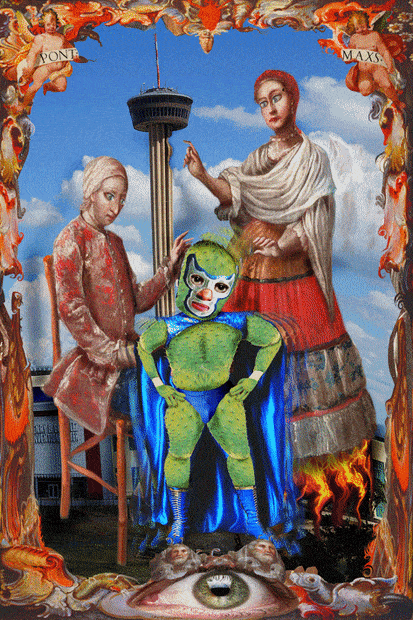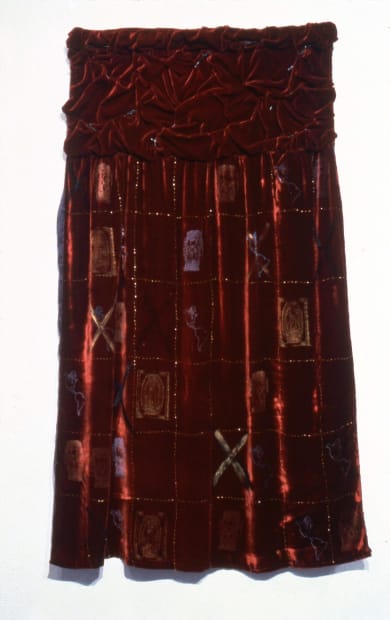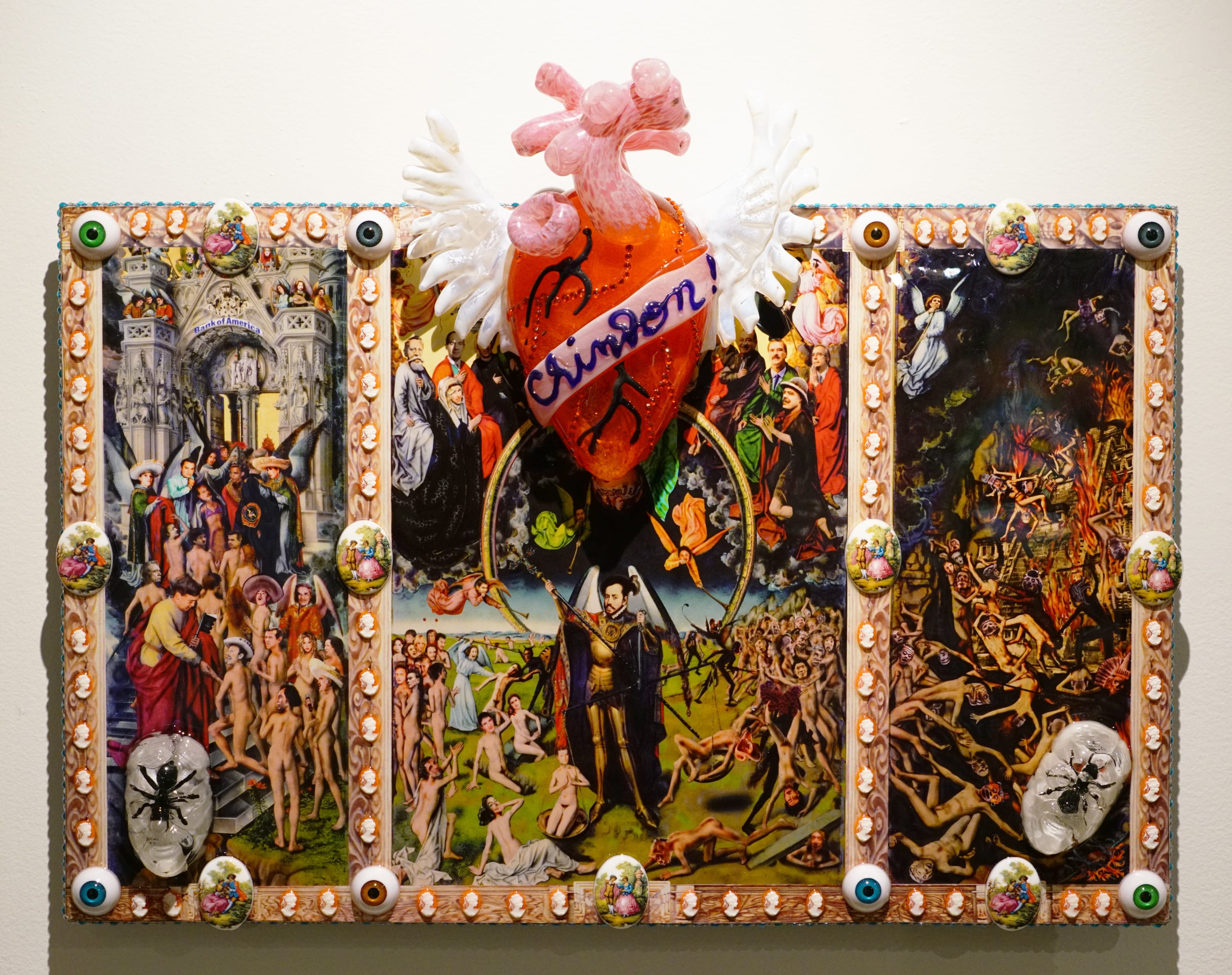-
Threading Glass: Consuelo Jimenez Underwood and Einar and Jamex de la Torre
San Antonio -
Ruiz-Healy Art presents Threading Glass: Consuelo Jimenez Underwood and Einar and Jamex de la Torre on view at our San Antonio gallery from April 9 to May 31, 2025. Threading Glass unfolds the reimagining of centuries-old craft traditions through a contemporary art lens, blending tradition with innovation. Artists Consuelo Jimenez Underwood and the de la Torre Brothers utilize history and personal experiences to create narratives that tackle multiculturalism, Latino heritage, and artisanship. This collection of works stimulates a dialogue between the tactile nature of both their practices, utilizing the rigid forms of glass and the flowing forms of tapestries as a vessel for social critique and a reaffirmation of craftsmanship as art.
-
“The craft process as always been ingrained in the human experience and is therefore an essential part of the evolution of material culture.”
- The de la Torre Brothers
-
 Consuelo Jimenez UnderwoodFather, Son and Holy Rebozo, 2017Woven wire, linen, metallic and cotton thread40 x 19 in
Consuelo Jimenez UnderwoodFather, Son and Holy Rebozo, 2017Woven wire, linen, metallic and cotton thread40 x 19 in
101.6 x 48.3 cm“The father-and-son reference indicates the Holy Trinity of Father, Son, and Holy Spirit in Catholic tradition, in which divinity is conceived as a male. Jimenez Underwood’s wicked sense of humor fuels her iconographic synthesis of these figures into specific hats worn by men. The artist interrogates and questions the construction of masculinity, the association of maleness with divinity, and the erasure of women and femaleness from positions of power and authority in the imagination of organized religions”
- Laura E. Perez, "Introduction," Consuelo Jimenez Underwood: Art, Weaving, Vision, Duke University Press, 2022.
-

-
The Latin Exoskeleton series is a collection of lenticular artworks that unravel the ongoing conversation of what it means to be “Latinx.” The artists do this by dissecting and appropriating Casta (caste) paintings, which were prominent in colonial Mexico and used to depict the social hierarchy and evolving lineage of 18th-century society. A Nopalero character dressed in a luchador uniform takes center stage in Nopalero de las Americas. The Nopalero’s skin mimics the coarse surface of a nopal cactus, alluding to the idea that coming from a diverse background encourages one to develop a strong exterior, challenging the negative undertones that Casta (caste) paintings often present. The lenticular’s background also features the Tower of the Americas in San Antonio, Texas, an iconic symbol of the city and a nod to the multiplicity of cultures that call San Antonio home.
-

-
"I tried to match the red color to the chile tepin, one of my favorite American spices, which still grows wild in some parts of Mexico. The barbed wire represents the colonial domination of the continent.”
Virgen de Tepin references a Huipil garment and a map, as its delicate golden grid line suggests. The lush velvet canvas contains barbed wire and silk-screened images, some of them covered with an “x”.
-

Einar and Jamex de la Torre
Chingon!, 2017Based on Hieronymous Bosch’s Northern Renaissance masterpiece, The Garden of Earthly Delights, Chingon! is a mixed-media triptych with nude figures occupying the three scenes possess the faces of celebrities, politicians, and other contemporary figures. On the right panel, ancient sculptures and figures containing Mesoamerican features are subject to fire and brimstone, whereas angels and saints greet the figures on the left panel. Clad in golden armor, the Spanish conquistador Hernán Cortés stands between heaven and hell.
-

-
Jimenez Underwood spent her childhood traveling California with her parents, who were agricultural workers. As her family traveled between Mexicali and Calexico, she became intimately aware of border issues from a young age. Lines and cartography frequently serve as subjects in her work, signifying spiritual, geopolitical, physical, and national borders and their impact on populations of plants, animals, and humans.
-

-
“Pre-Columbian deities, Mexican lucha libre wrestlers, Olmec heads, Slavic water spirits — the de la Torres’ visual universe is vast and pantheistic. The brothers freely mix high and low, in part, they say, to challenge entrenched ideas about beauty and ‘good taste.” Patricia Escárcega, “De la Torre Brothers Are Making the Most of Maximalism.”
- The new york times
-
 Consuelo Jimenez UnderwoodGreen Hills, 1985Woven dyed linen and nylon thread, green steel wire38 x 60 in
Consuelo Jimenez UnderwoodGreen Hills, 1985Woven dyed linen and nylon thread, green steel wire38 x 60 in
96.5 x 152.4 cmGreen Hills was the first weaving Jimenez Underwood created after moving to Cupertino, California, where the rolling opulent green landscape surrounded her and her family’s new home, a stark contrast from the metropolis of San Diego, their former home. The work depicts hills,valleys, borders where humans made their marks, and fences, like scars torn into the green flesh of the Earth.
-
-
Both Consuelo Jimenez Underwood and the de la Torre brothers incorporate the nopal cactus as a central motif in their work, a common iconographical symbol of Chicano art. The de la Torre brothers’ Virgen Nopalera fuses Chicano iconography with Virgen de Guadalupe’s mandorla, featuring a nopal adorned with cactus flowers, thorns, and resin-encased baby dolls. In Corazón Nopalero, the cactus grows from the heart's valves, symbolizing the artists' deep connection to their heritage. Jimenez Underwood’s Undocumented Nopal 2525 AD uses the cactus as a symbol of resilience in a post-apocalyptic world. With its barbed-wire spikes and flames, the cactus represents both environmental concerns and the enduring spirit of the nopal cactus, indigenous to North American soil.
-

-
“We are all guilty- we're not above overconsumption by any means and humor is absolutely necessary to deal with the absurdities of existence”
- Jamex de la Torre
-
The de la Torre brothers use humor to critique and analyze the world around them. In Letting Them Eat Cake, a glass pig on a silver platter offers a slice of cake, nodding to Marie Antoinette’s infamous gesture, offering a dark commentary on privilege. In Napoleon Complex, a resin-cast bust of Napoleon Bonaparte, encased in gold chains, coins, and pearls, rests on a silver platter, creates a multi-layered critique of wealth, ego, and power.
-
 Einar and Jamex de la TorreSmakelijk, 2013Archival pigmented lenticular print, blown glass, and mixed media40 x 40 x 6 in
Einar and Jamex de la TorreSmakelijk, 2013Archival pigmented lenticular print, blown glass, and mixed media40 x 40 x 6 in
101.6 x 101.6 x 15.2 cm -
Two female busts, styled as Roman sculptures, are displayed on an ornate resin-cast shelf. Their differing sizes represent status and authority, referencing the hierarchical nature of Western civilization. This piece was part of Le Point de Bascule (The Tipping Point), an immersive installation at the McNay Art Museum, where remnants of a feast and taxidermy objects evoked the history of “cabinets of curiosity.” In L’eau de David, a bust of King David is surrounded by objects like a “Kingpin” with bowling pin and vintage cologne bottles. The scent of aged cologne satirizes traditional masculinity, critiquing the commercialization of gender ideals.
-
 Einar and Jamex de la TorreE.R. for the Soul, 2010Blown glass and mixed media41 x 28 x 8 in
Einar and Jamex de la TorreE.R. for the Soul, 2010Blown glass and mixed media41 x 28 x 8 in
104.1 x 71.1 x 20.3 cm
Threading Glass: San Antonio
Current viewing_room


















